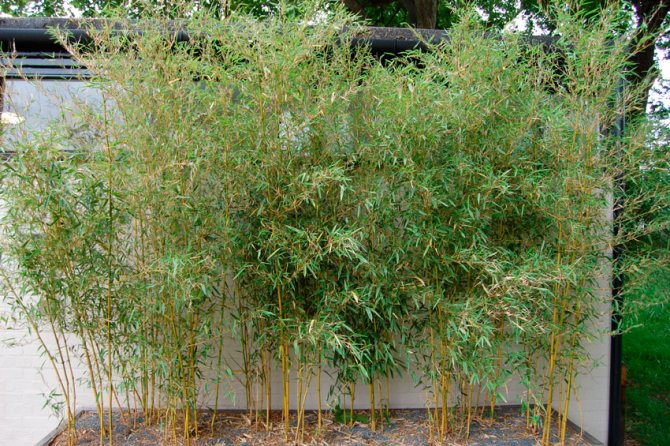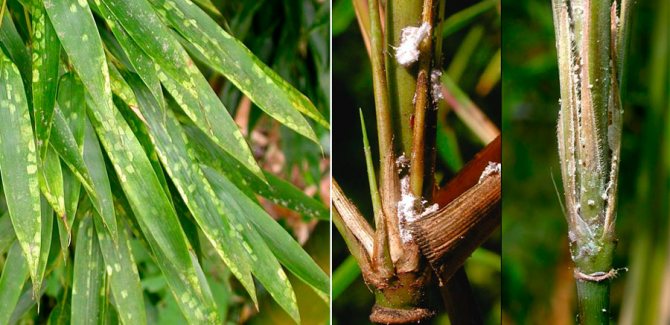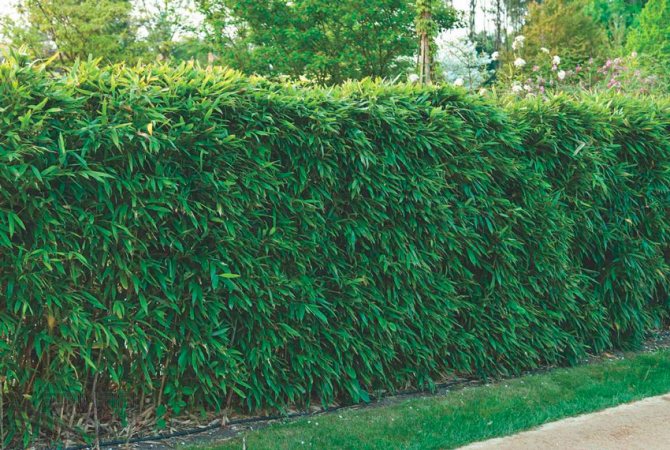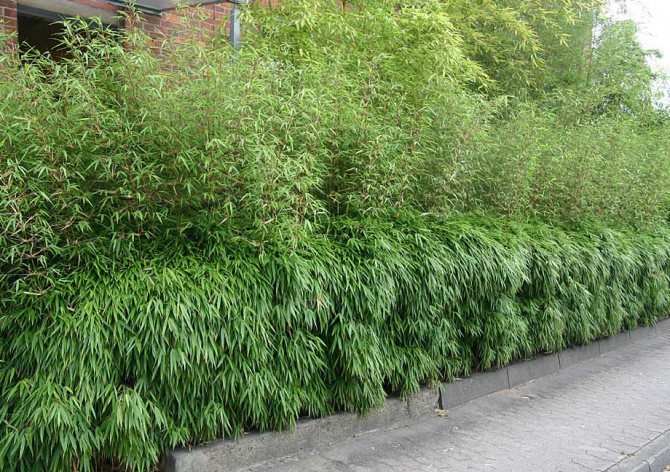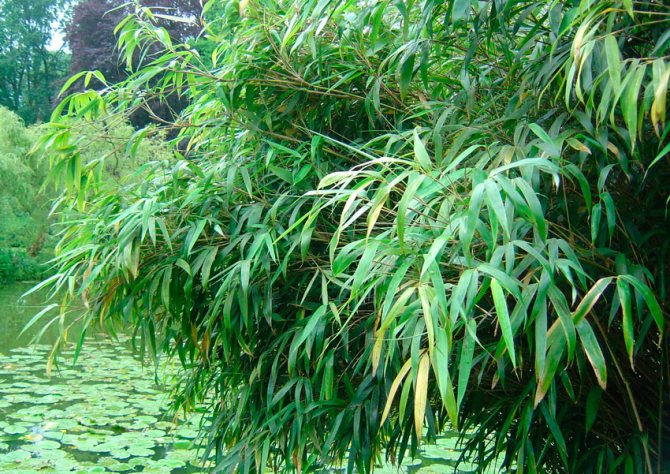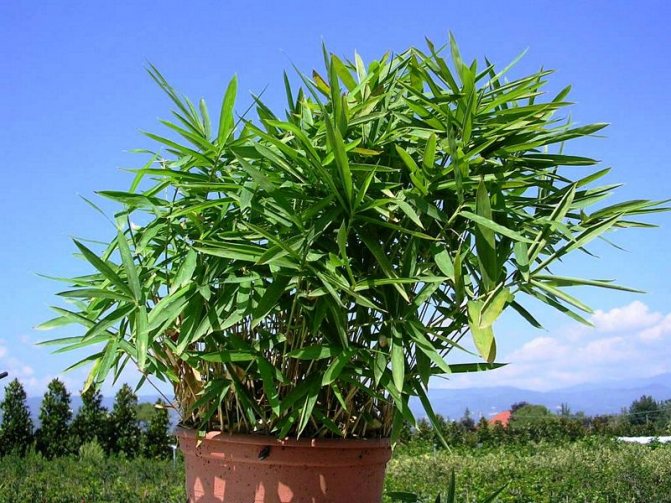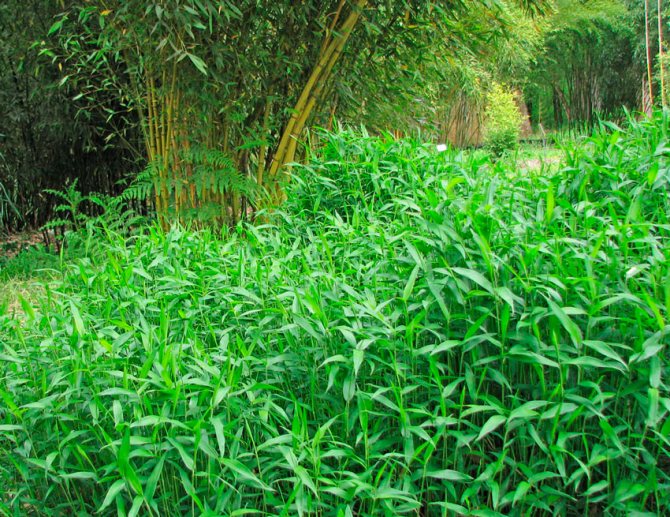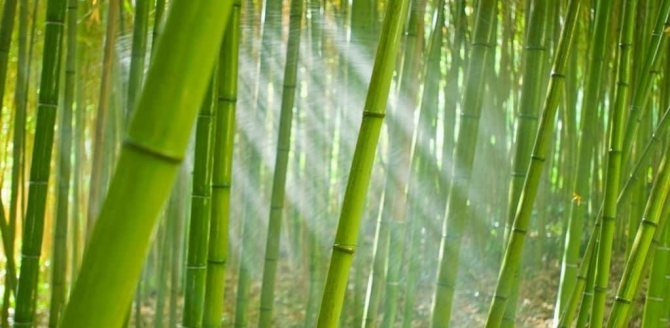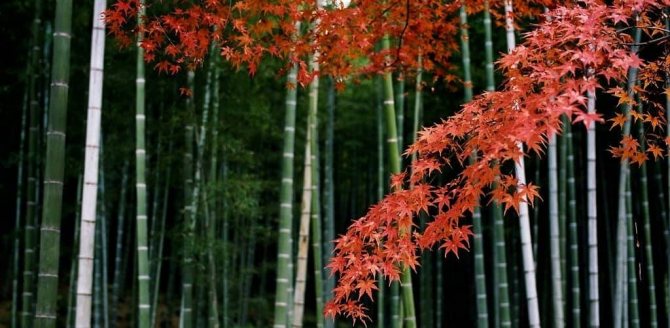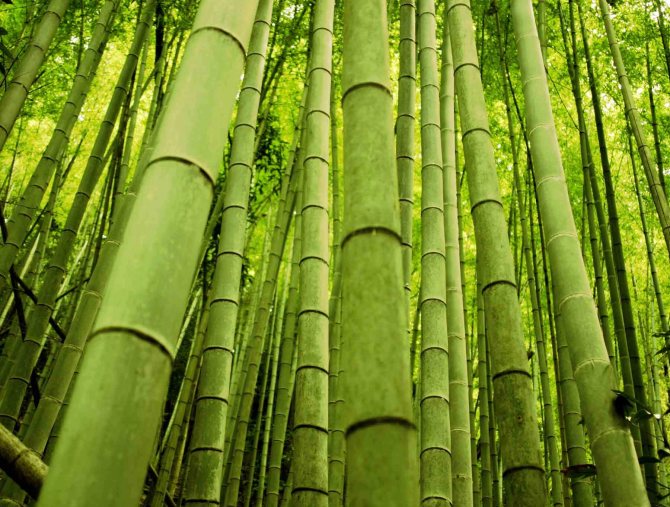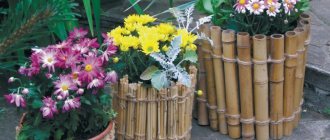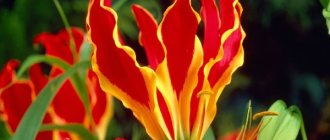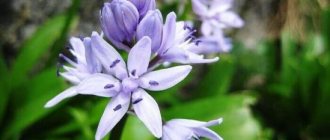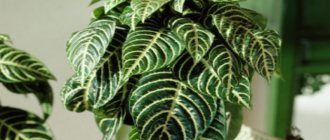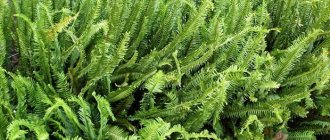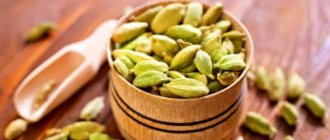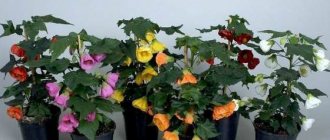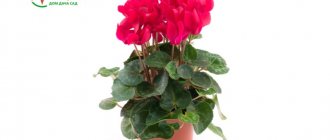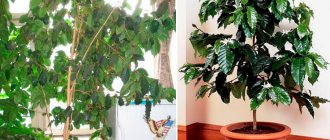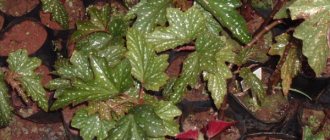What is bamboo
Bamboos are a huge family of cereals, to which more than a thousand species belong. All of them are evergreen, almost all of them grow to large sizes. The family includes herbaceous, vines with climbing or climbing branches and plants with thick ligneous shoots.
For decorative purposes, the following cereals are also grown: pennisetum, miscanthus, haretail, fescue, cortaderia, feather grass, blue and reed thorns, cylindrical impera, bristle grass, turf pike.
Most of the species prefer the climate of the tropics and subtropics, humid shady jungles, some grow and develop in harsh conditions, for example, in the Kuril Islands, in the Himalayan and Andes mountains on the border with snowy peaks.
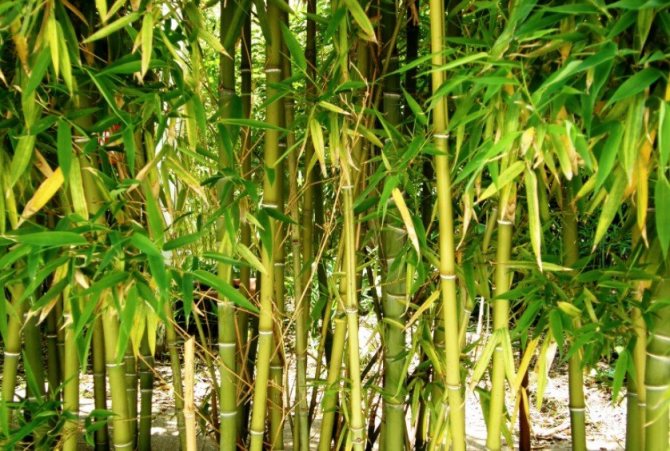
The use of the plant is quite diverse, its various parts are used in such industries:
- medicine;
- cooking;
- building;
- gardening (landscape design);
- furniture industry;
- light industry (haberdashery, household items, tools, textiles);
- raw materials industry.
Did you know? The bow of the Japanese samurai was made from bamboo stalks using complex processing. Today, sports onion equipment is produced using the same technology.
Features of the
Bamboo has a number of properties that distinguish it from other plants:
- incredible strength of the stems. In his striving to germinate, he can even split a stone that gets in his way;
- growth rate. The highest growth rate belongs to the phyllostachis madake species - 120 cm per day;
- the least studied flowering. Most species bloom very rarely, once every 20-60 years, but they bloom all at once and die off immediately after fruiting. True, only the aboveground part dies off, and the rhizome is capable of growing a new generation.
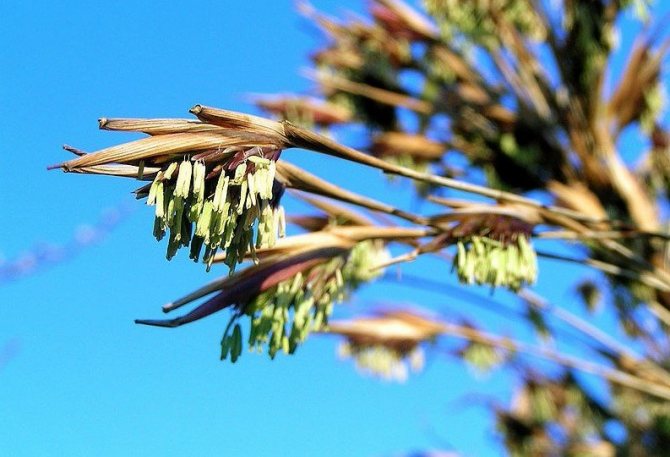

Meals, transplant
Regular feeding is very important for the plant, as bamboo consumes a lot of nutrients at its growth rate. In spring and summer, it must be watered with nitrogen-containing fertilizers every 2 weeks (you can use lawns). In autumn and winter, it is better to give him a break from feeding.
Given its rapid growth, it is necessary to transplant young plants every year, for adults it is enough once every two to three years. You can do this both in spring and in summer, it is advisable only to choose cloudy and cool weather. The substrate for bamboo needs to be quite heavy and nutritious. You can take ready-made soil for palm trees. If it is possible to compose it yourself, then you need to prepare 2 parts of clay turf, add 1 part of peat and 1 part of humus.
The roots of the plant are very strong and powerful, in some species they are even tough and sharp, so you need to be especially careful when transplanting so as not to hurt yourself or damage the pot. If it is plastic, it often has to be cut - otherwise the plant cannot be removed. If the plant is old enough, it will be better to transplant it directly into the tub. Drainage is required in any case.
Types and varieties of bamboo
Consider the most interesting plants of this family for growing.
Saza
Bamboo resistant to cold, common in Japan, Korea, Sakhalin, the Kuril Islands, in the mountains of China.
Strong, cylindrical shoots, lignified in the lower part, grow up to three meters.The stem is marsh-green, about one centimeter in diameter, bears single branches with leaves at the ends.
Learn how ornamental plants are subdivided.
Sheet plate —
up to half a meter long, wide, oval in shape. By autumn, the edges of the leaves dry up. It rarely blooms, the inflorescence is a panicle consisting of spikelets.
Saza is used in weaving baskets and light furniture, in agriculture it is used to fix soil on slopes and along river banks.
The most common varieties of sazi that can be grown outdoors in mid-latitudes are:
- Kurilian;
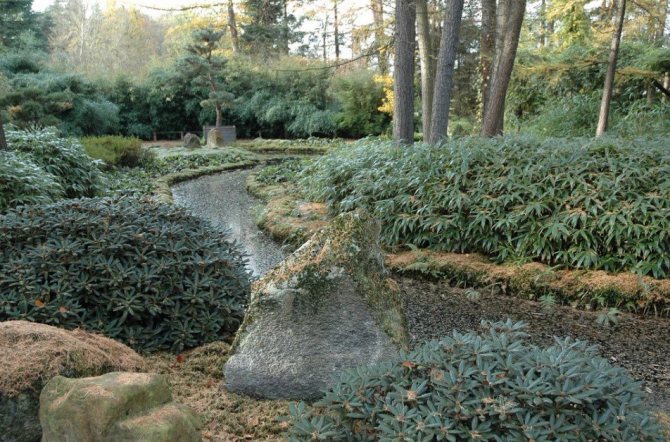

- Vicha;
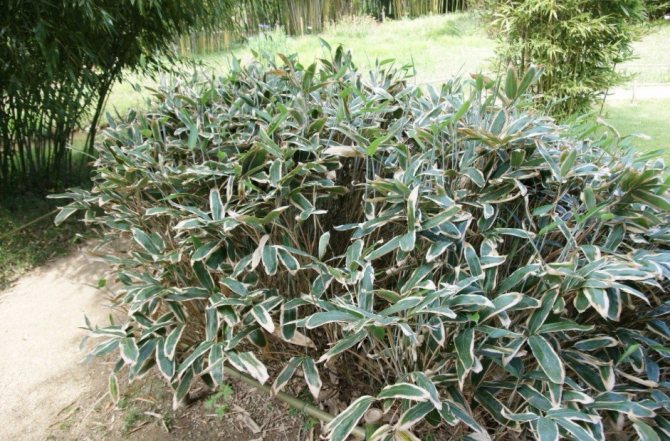

- long spikelet.
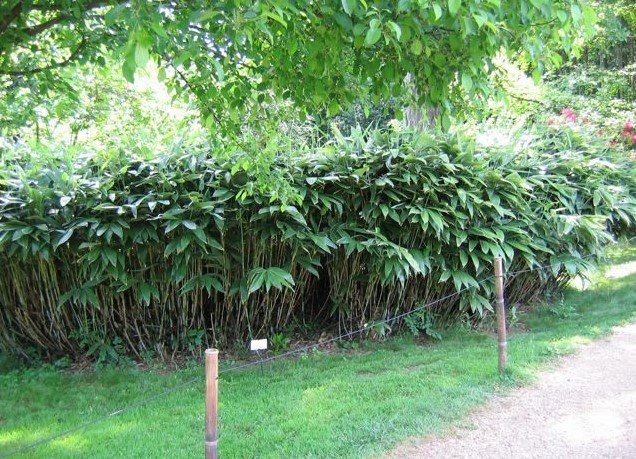

Fargesia
Fargesia is native to China, distributed on its mountain slopes. Evergreen, like all bamboos, grows from half a meter to two meters, it grows bushy. Shoots are thin, depending on the variety, brownish, green or reddish.
Check out our list of the best ornamental shrubs for your garden.
Branches with long and narrow bright green leaves develop on numerous shoots. In the autumn, the leaves become yellowish. It is adapted to our latitudes, withstanding frosts down to -30 ° C, the Fargesia is brilliant, or rather, its such varieties:
- "Eisenach";
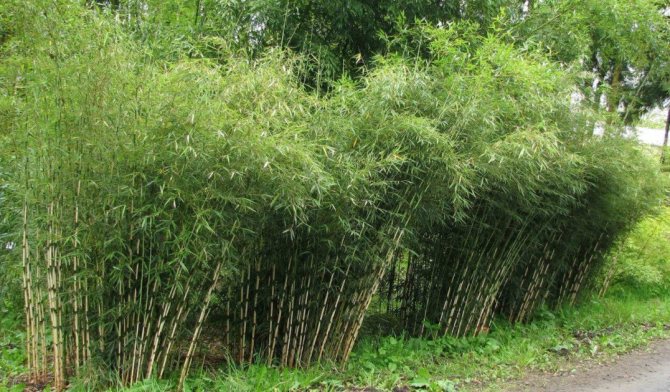

- McClure;
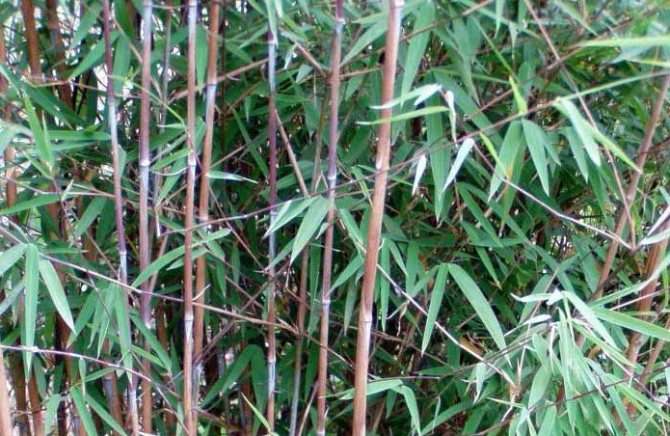

- "Nymphenburg".


Phyllostachis
Phylostachis grows on wet, but not swampy soils, in China, Japan, Europe, Crimea, America. One of the cold-resistant types, withstands temperatures down to -18 ° C. Grows in thickets, growing up to 20 meters, stem diameter up to 15 cm. Young shoots are bright green in color, turn yellow as they age.
Check out our list of the best ornamental herbs for your flower bed.
Leaves are narrow and long, with short petioles. It is this species that holds the record for growth. Blooms, reaching 50 years of age, inflorescences - fluffy panicles.
Popular varieties and varieties of Philostachis:
- Bissetii;
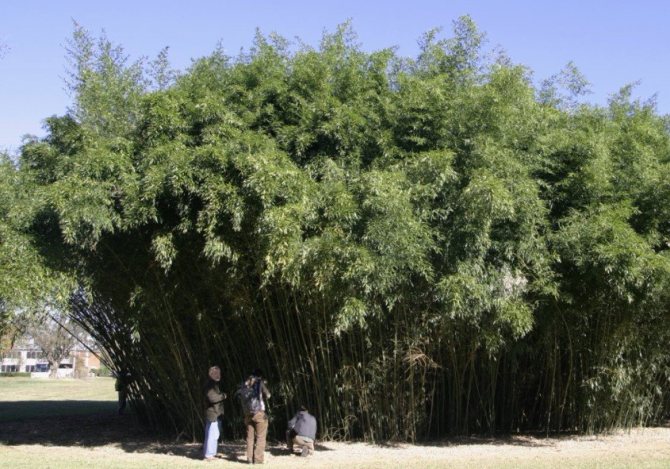

- "Nigra";
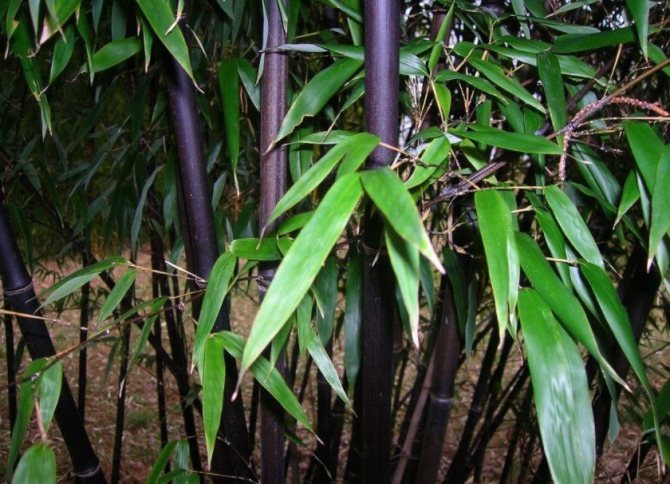

- "Aurea";
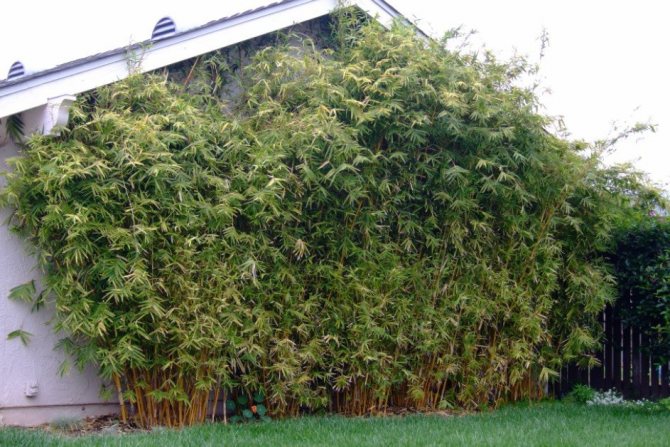

- Green Perfume.
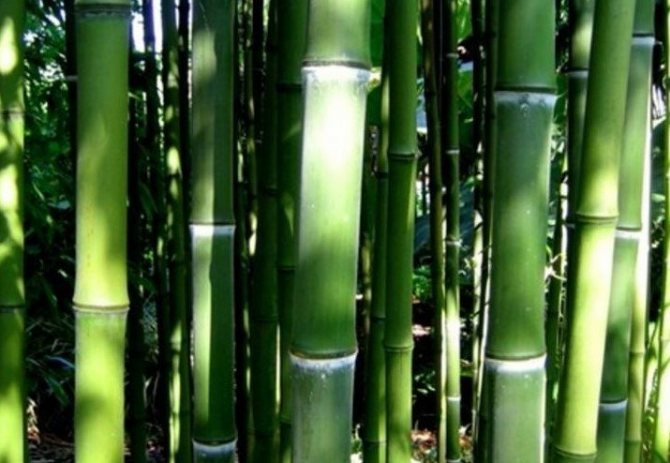

Did you know? The leaves of phyllostachis "bisseti" are used to make delicious and healthy tea.
Pleioblastus
The variety is native to Japan, it grows in China and Vietnam. The people call it a multi-flowering plant, because of the dense thickets that it forms when it grows. In nature, it grows up to a meter and more, but in the middle lane —
up to 60 centimeters.
Shoots are slender, heap growing, leafy. The foliage is elongated and narrow, up to 30 cm, grows so densely that the petioles and twigs behind it cannot be seen. Varieties can be colored in different shades:
- golden;
- yellow-green;
- bluish;
- bright green.
The following varieties of pleioblastus are suitable for growing in our conditions:
- Simone;
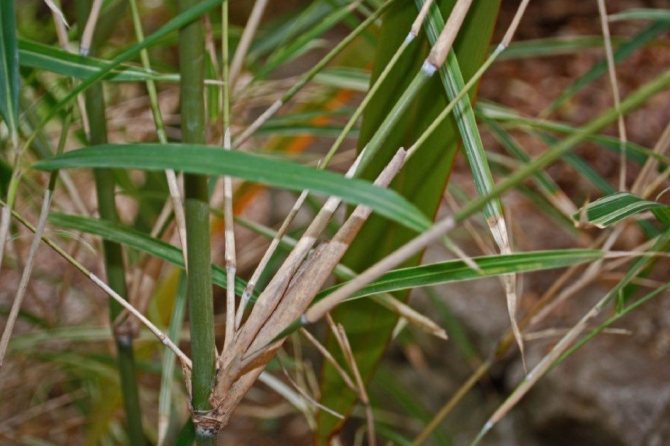

- green stripe;
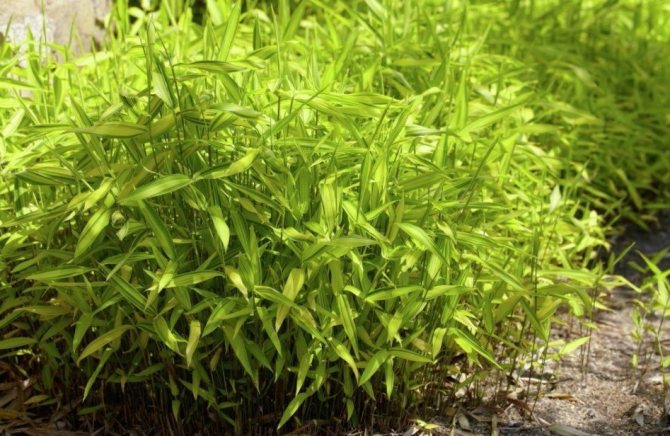

- Fortune;
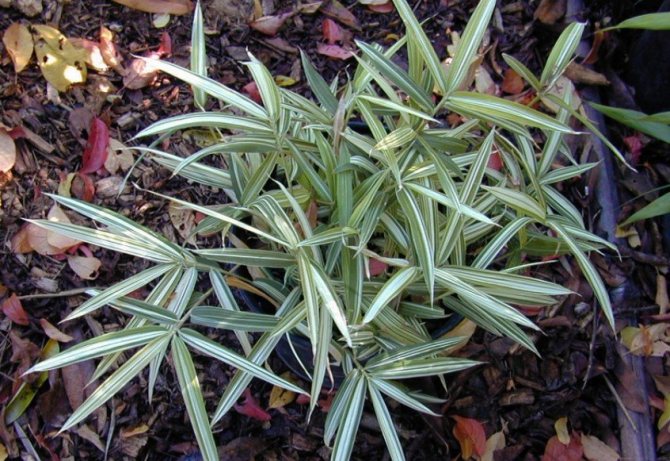

- silver.
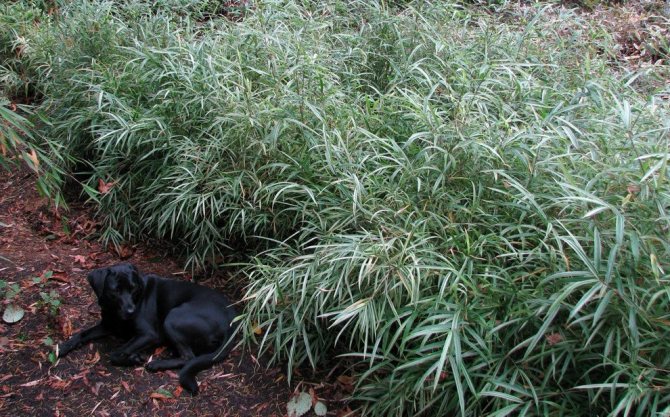

Common bamboo
The most common type of plant, lives mainly in the tropical forests of Asia, Africa, Madagascar, USA. In cold climates, the plant is best grown as a pot culture, since it can only withstand the not very low temperature of -3 ° C.
Learn about the nuances of choosing hedge plants.
Growing, it forms not too dense thickets of strong stems up to twenty meters high. The leaves grow densely, the plates are covered with a light nap, in the form of an irregular oval, pointed at the end.
The following types are popular in culture:
- green-bore;
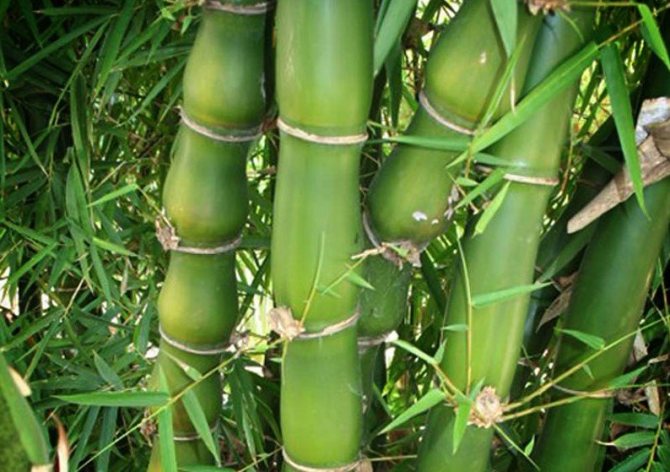

- gold;
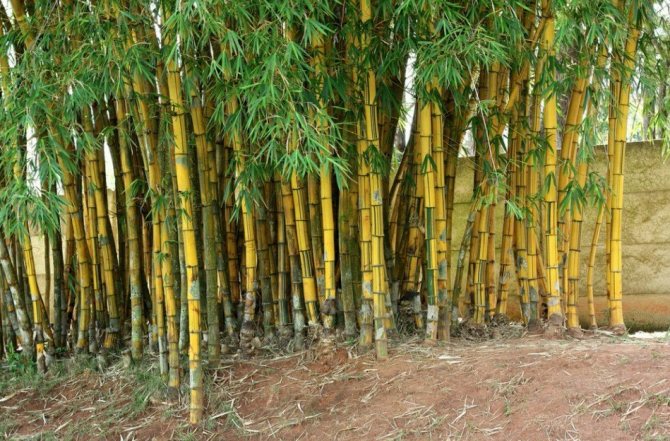

- Wamin is three meters high.


Did you know? The bamboo bridge over the Ming River in China, built in the third millennium AD, is still in use today. Its length
—320 meters, suspended structure, bamboo cables serve as supports.
Only pluses
Among plants, the universal bamboo has no equal in the breadth of the spectrum of use. It is cheap, has almost the same manufacturability as wood, its strength exceeds that of most tree species. Bamboo products are easily compostable.
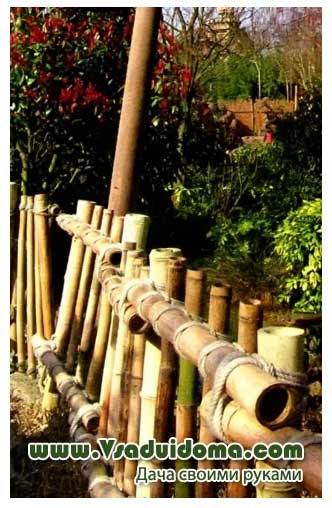

Popular in low-rise construction: a simple and ideal material with high fire resistance provides great thermal insulation, sound insulation, high comfort. It provides pleasant opportunities for creativity - a varied diameter of the trunks (1-15 cm), ease of cutting when adjusting the length, resilience and elasticity to create curved shapes.
The smooth, fibrous structure of the trunks, various colors (white, yellow, green, almost black) are ideal for finishing surfaces and creating furniture. Bamboo combines and harmonizes with natural materials - clay, straw bricks, wood, stone, lime, cement, hemp and palm ropes.
Planting bamboo
When planning to plant bamboo on your site, take care of the choice of neighbors. It can be:
- other decorative cereals;
- host;
- ferns;
- astilba.
Choosing a place on the site
It is best to choose a site for planting in the south-east or south-west, sheltered from the wind. It can be a closed patio, a place near a high continuous hedge, an ideal place would be a place near a pond.
There is no special requirement for the composition of the soil in bamboos; the only type of soil that does not suit it is heavy clay soil. Acidity is desirable within 6 pH, sufficient moisture and nutrition, otherwise watering will have to be given more time.
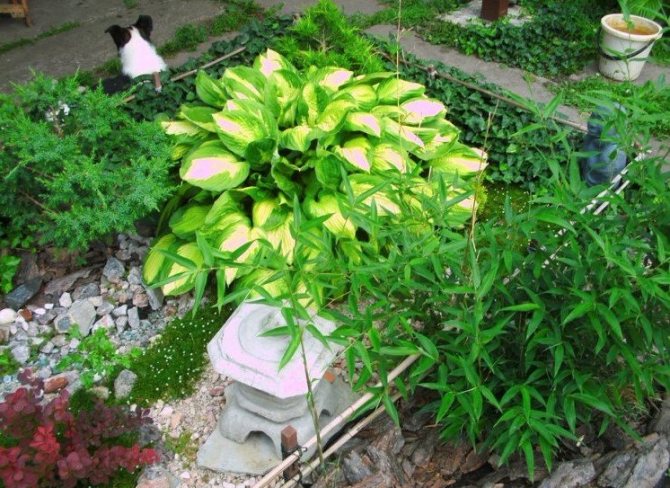

Conditions
Since bamboo is more of a tropical plant, it requires close to natural conditions. It is not advisable to plant in the sun, despite the resistance to heat, the leaves burn out from the direct rays of the sun. In extreme heat above + 25 ° C, it is advisable to spray the foliage in order to increase the humidity of the air.
Learn how to grow Ziziphus, Actinidia, Eukomis, Arizem, Pomegranate, Annona, Knifofia, Hymenokallis, Anguria, Azimina, Feijoa.
Landing
The best time to plant —
the interval from April, when the soil is well warmed up, to June. Before planting, the seedling, along with the container, is placed in water to remove air. After the air bubbles stop appearing, it is lowered into a prepared hole.
A bamboo pit is prepared with a volume twice as large as the root system of the seedling. The bottom is covered with a layer of garden soil with humus in equal parts. The seedling is lowered onto the embankment and covered with the same mixture as at the bottom of the pit. Sprinkling the roots, the earth is tamped, sweeping out the air gap. After planting, abundant watering is carried out.
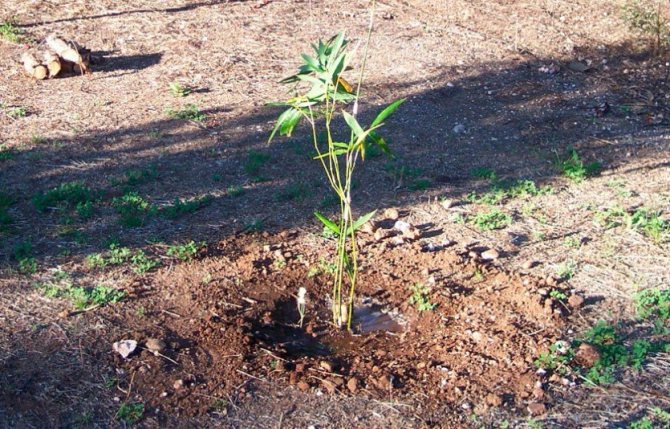

Watering
At first, the moisture-loving seedling is watered often and abundantly, especially if there is no precipitation. When growth begins, watering is reduced to two times a week. In the presence of precipitation, watering is not needed.
Important! The soil in the near-trunk circle should not be too wet, it should have time to dry out a little between waterings.
Growth restraints
Bamboo has a very living rhizome, it can grow very wide, capturing large areas. Therefore, in home cultivation, the growth of root shoots must be inhibited.
The easiest way is to dig slate sheets to a depth of up to one and a half meters along the perimeter of the site where the plant is planted, which will serve as growth restraints. The sheets should not be interconnected end-to-end, the shoots will be able to germinate through the seams, but overlap.
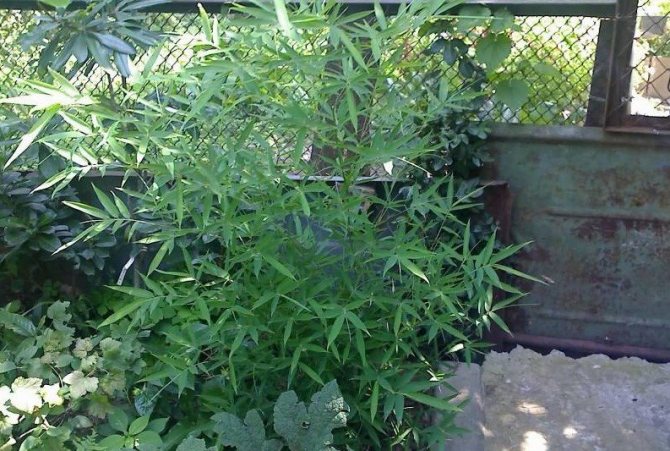

Pruning
The plant does not need particularly careful pruning, but every year old branches and shoots that do not have a decorative appearance should be removed, the bushes should be thinned so as not to breed moisture, and with it diseases.
Important! If you want to restrain the growth of the shoot, it must be shortened below the knot.
Top dressing
Fertilize the plant twice a season with mineral fertilizers:
- in the spring - a complex of nitrogen, phosphates and potassium (proportion 4: 3: 2);
- in the fall - nitrogen, phosphates and potassium (2: 4: 4).
Wintering
Under the condition of a snowy winter, frost-resistant varieties can be grown without shelter, but it is better to play it safe.After the first frost, shoots should be bent down, covered with dry foliage or sawdust, covered with spruce branches or lutrasil, Kraft paper on top, and then, when snow appears, heated over a snowdrift.
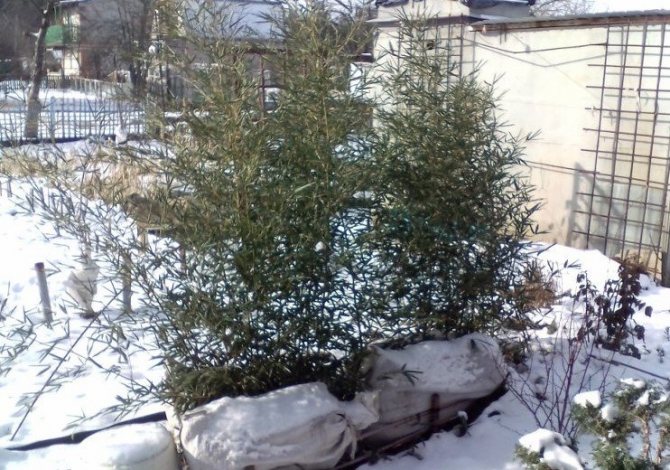

Conditions for growth
Most species prefer soil with an acidity of pH 6.0-6.2. Bamboo loves sunny, slightly shaded places. Freshly planted bamboo needs plenty of watering, but the water should not stay in the plant's root system for long. Fertilizers should be high in nitrogen and preferably with a thick layer of humus. At the same time, over-fertilization weakens the plant. Tall bamboo must be tied to a stick. Mulching helps to retain moisture and protect the roots from frost. In areas with severe frosts for the winter, it is necessary to cover the soil with a thick layer of foliage or other covering material. It is better to leave your fallen leaves on the soil if they are not infected with diseases or pests. Hay, straw, dry grass are good for mulch too if they are seedless.
After planting, there is a continuous nursing process.
Breeding types
Reproduction by seeds is possible only with the purchase of seeds, since bamboo blooms and, accordingly, bears fruit very rarely. It is easier to propagate it vegetatively at home.
Seed reproduction
Before sowing, the seeds are prepared by soaking in warm water for several hours. Then a seed is lowered into the peat cups with the tip down, deepening its length to the floor.
Crops are placed in a box under the film and placed in a warm place. For seedlings, a temperature of about + 30 ° C, good lighting and constant ventilation are important so that condensation does not form on the film and mold under it on the soil.
Find out what kind of lamps are available for illuminating plant shoots.
Seedlings appear in two weeks, they are immediately transplanted into separate pots. When the plant gets stronger and passes hardening, they look for a permanent place for it on the site.
Video: bamboo from seeds
Vegetative propagation
In planting, several strong three-year-old shoots are chosen, dug out and transplanted into the shade, while cutting them off by a third of the length. Every day the seedlings are watered abundantly. After rooting, they look for a permanent place.
The second way of reproduction is by dividing the rhizome. In the spring, a rhizome with shoots is dug, several shoots must be left, and carefully divided into parts. It is dripped in the shade and watered until it takes root. Then they are transplanted to the chosen place.
Confusion in names
Very often, many other plants are hidden under the name bamboo. Some of them are his relatives, sometimes close, and some have nothing to do with him, except for some external similarity. Only the genus Bambusa (Bambusa) is true, which contains about 130 species. But he belongs to the tribe and subfamily bamboo, among which many more genera are known, similar in appearance to our hero.
In particular, on the Black Sea coast of the Caucasus and in the Crimea, Phylostachis or leaf grate is widespread and of great economic importance. But it resembles bamboo so much that everyone calls it that. And in the Far East, it forms whole thickets of Kuril Saza, which is also called the Kuril bamboo.
And in room culture, the so-called "luck bamboo" is widespread, which has nothing to do with it at all. This plant is Dracaena Sander.
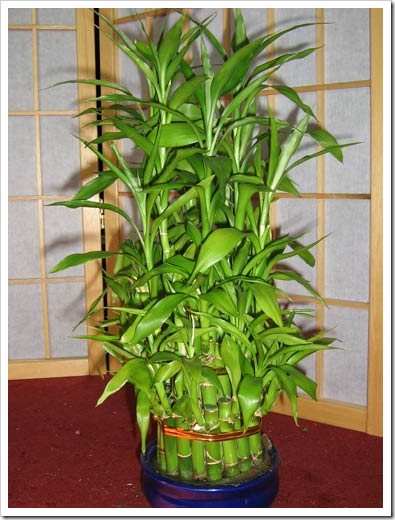

Dracaena Sandera - sold as "fortune bamboo"
When buying, you must carefully consider the label with the name of the plant in Latin. And, regardless of how it will be called in Russian, the Latin name must contain the word bambusa - this is a sign that the bamboo is real.
Diseases and pests
Bamboo has an unusually good immunity to diseases and pests, but it does not grow alone in the garden and can be attacked by insects or diseases. Spider mites and mealybugs were most often seen on plants.The first is disposed of with the help of acaricidal preparations, the second is helped by insecticides.
The most effective remedies:
- "Masai", "Sanmai", "Apollo" - acaricides;
- "Aktara", "Mospilan", "Ponche" - insecticides.
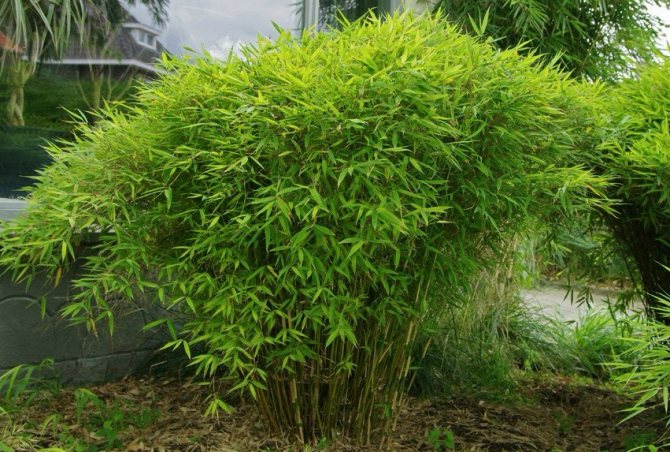

Bamboo turns yellow
In some varieties, yellowing in the fall is natural, consider the reasons why the leaves turn yellow at other times:
- due to decay of the roots, as a result of waterlogging;
- due to lack or excess of food;
- soil salinity;
- too aggressive lighting;
- the appearance of an infection.
The infection must be fought with fungicides, for example, "Strobi" or "Falcon", and others.
As for the rest of the reasons, leaving has its own nuances that must be taken into account:
- Do not overmoisten the soil.
- On heavy soils, drainage is placed in the pit.
- Bamboo does not like an abundance of fertilizers, it is better not to add here.
- Do not plant in direct sunlight, there should be a light shade.
- Check the salt level in the soil and deal with excess salt. You can get rid of salt by adding gypsum or planting green manure plants, for example, alfalfa, which literally draw out salt with root shoots.
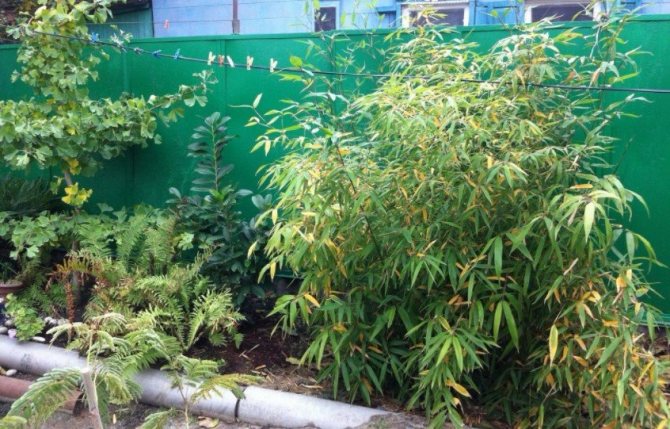

Bamboo —
an excellent ornamental plant, it can decorate any design idea, and its shoots can serve in everyday life. In addition to open ground, the evergreen plant can also be grown at home.
Video: bamboo in a personal plot
Abundance of opportunities
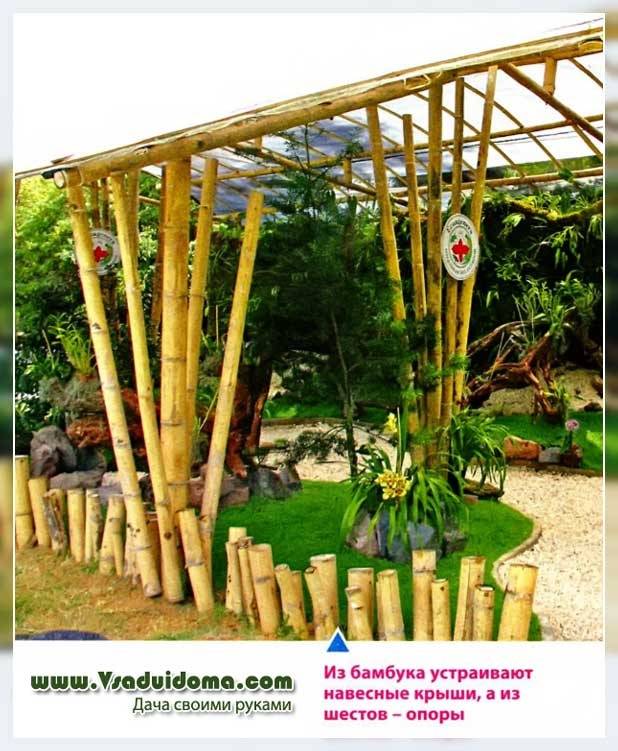

New technologies for processing wood make it possible to make almost everything from bamboo that was traditionally made from wood. Houses, summer grounds, kitchens and green theaters, utility blocks, beach bungalows, small platforms and rafts, bridges, water pipes are built from light, hard and very durable wood. The slightly curved bamboo trunks are joined together to form arched structures that support the hinged roofs. Bamboo is used for scaffolding, rebar and formwork.
In temperate gardens, bamboo is affordable, it is used where a small amount of material is required: gazebos, pergolas, trellises, decorative trellises, supports for climbing and climbing plants, flower supports, fences.
Country houses are equipped with bamboo products - overhead ladders on the roof, ladders, water gutters, lamps, wind chime pendants, blinds, curtains, carpets, durable and light garden furniture, greenhouses - with shadows, household utensils - pots and containers for garden and indoor plants, wicker baskets, dishes, mats, etc. Various tools with bamboo handles (rakes, paint brushes, shovels) are suitable for gardening.
IMPORTANT
Lucky bamboo, Chinese bamboo is Sander's dracaena, which has no kinship with bamboo, but very much resembles bamboo stems with a rounded shape and green color.
In the garden, bamboo supports are made for climbing plants.
In India, bamboo is a symbol of friendship.
Today, bamboo organically fit into various directions of garden design, without a strict ethnic orientation.




